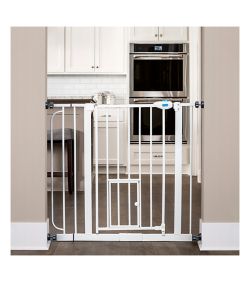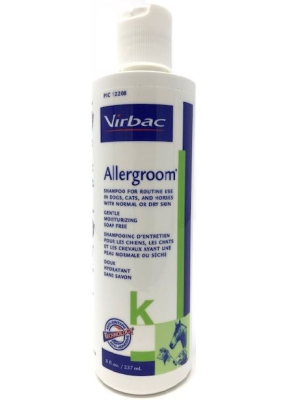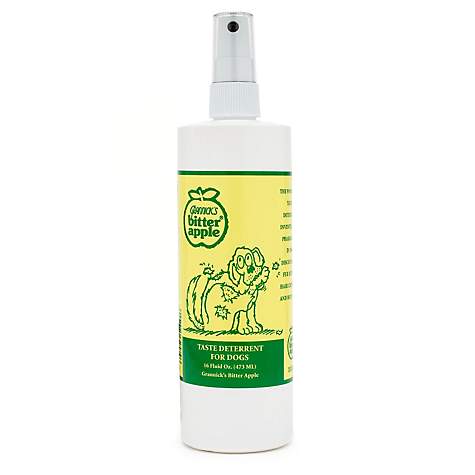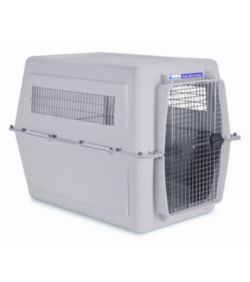Puppy Proofing Checklist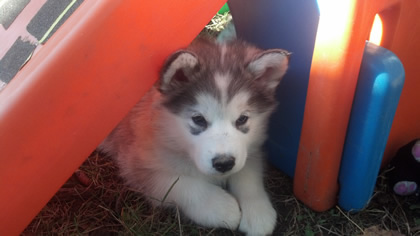
Puppies will chew. There's no way around it. A lot of chewy toys help, but it's not a total solution! Here is a checklist of things to remove, hide and put away when you have a new puppy....don't say I didn't warn you!
There is no such thing as a "bad" puppy - all puppies get into trouble, but a Malamute puppy can find things you never thought of! It is up to the owner to be sure that the puppy understands appropriate behavior and that the house is safe and secure. All the no-chew sprays in the world don't make up for teaching your puppy what is appropriate and what isn't. Until then, you will have to be constantly on guard. Walk around on your hands and knees and think like a curious puppy - what catches your attention? Loose dangly things, chair legs, phone cords....temptation is everywhere. Food left on countertops/tables, accessible garbage, potted plants (which could be poisonous) to dig in or chew. Keep strings, yarn and thread away from puppies. A string obstruction of the intestine is a very serious surgical emergency) and other tiny swallowable objects (children’s toys, needles, pens and pencils, pennies (toxic), safety pins, cotton balls, etc.,) and low open windows and screens that can be jumped through. Of course, don’t forget the valuable breakables (we had a puppy once accidentally break a $400 Lladro, but they still love him! And we know a puppy (not ours) that chewed a $2,000 porcupine quill box). Don’t leave this stuff out! Malamute puppies can have expensive tastes!
When you get a puppy your slovenly ways are over - it's time to become a neat freak and keep clutter picked up and put away. Puppies, like small children, explore the world with their mouths...it's YOUR job to make sure that world is safe!
Inside
- Toxic Plants (get rid of 'em), and other plants including cactus (put up high)
- Put Poisons, Medicines, cleaning supplies or anything toxic up high.
- Potentially dangerous foods within reach or on countertops should be removed: sugarless gum (xylitol), coffee grounds, chocolate, tea, alcohol, hops, salt, onions and onion powder, grapes and raisins, avocado, garlic, and macadamia nuts.
- Computer and electrical cords - make them inaccessible.
- Clean off your desk (papers, wires, small items that can be snatched and eaten)
- Trash cans, especially with plastic bag liners (get a trash can with a difficult to open lid)
- Water dishes that are too full (they'll get dumped or played in)
- Loose mouldings or things that can be pulled and chewed
- Toilet paper and paper towels - in fact, anything paper is a puppy magnet to shred
- Soap and shampoo in the bath tub (get one of those hanging racks if your shelf is low)
- Strings, yarn, thread or venetian blind cords
- Glue down any loose wallpaper corners or edges (they'll be found and walls stripped of coverings)
- Children's toys, especially small swallowable ones and dolls with long hair
- Scented toys - markers, dolls
- Collectible and breakable items - Remove these from tables and put up high or behind glass in a curio cabinet
- A dangling phone cord
- Items on a nightstand (keys, wallet, medicines)
- Curtains that go to the floor (especially delicate sheers)
- CD's in a low rack
- Speaker wires and the playstation
- Extension cords, TV and Appliance cords
- The cat's litterbox (they love to eat the cat poop)
- The cat's food
- Carpet edges with pullable threads
- Hanging bedspreads
- Stacks of papers or books that are low or on the floor
- Remove knick nacks on low tables
- Loose edges on floor tiles (can be pulled up)
- Low knobs on furniture (bitter apple to the rescue)
- Cell phones
- Toilet Plunger and Cleaning stuff in bathrooms
- TV and VCR Remotes
- Computer keyboards (cover with saran wrap to keep slobber out)
- Needles, pins, pennies (toxic), and anything small and sharp or that could be swallowed
- Throw Rugs with fringe, actually any throw rug...
- Shoes and Slippers
- Purses, wallets (esp. if made of leather)
- Clothing that hangs low in a closet
- Remove or hide plug in air fresheners
- Items on the back of the toilet tank or on the sink
- Clothing on the floor or back of the door hanging low enough to jump up and pull
- Be aware they may chew furniture corners and table and chair legs (supervise and use your bitter apple)
- Books on a low shelf in a book case
- Fire place equipment (esp. brushes and wood)
- Replace low screens with pet proof screening
- Make sure low windows or windows near a bed can't be jumped out of
- If you use a doggy door, make sure you can lock it when you're not home or it's a muddy day.
- Keep the dog food in a secure place (many a puppy has opened cabinets or gotten into bags just sitting on the floor!)
- Food and items on kitchen countertops
- Remove toxic cleaners from the toilet tank and close the lid.
- Keep cigarette butts and ash trays out of reach.
- Use a toy box for his toys that doesn't matter if it's chewed on (no expensive baskets, you'll be replacing it often)
- Protect wicker furniture and baskets as they are very tempting to chew
- Make sure low cupboards with food or cleaning supplies are secured with babyproof latches
- As your puppy gets older and can reach, just use the back burners of the stove until he learns to stay off (you should've been working on this)
- Newspapers and magazines lying around or in racks
- Vacumn cleaner cords
- If you have an older house, beware of lead paint on mouldings and walls that may be flaking or chewed
Outside:
- A SECURE fence - something that can't be knocked over, dug under or chewed through (chain link, privacy fencing, block wall....etc.) at least 4 ft. high, higher if you get a lot of snow in your area
- Holes or gaps in and under fences more than 4" in diameter
- Sticks and small stones in the back yard
- Remove toxic shrubbery and flowers
- Lead painted wood that can be chewed
- Dirt piles for digging, bare or muddy areas (woodchips or straw work well to cover these areas)
- Toadstools and toads (toxic)
- Fence off gardens and flowerbeds (they'll get the harvest first!)
- Make areas under porches inaccessible (nothing like trying to get a stubborn puppy out of those places once they've found them!)
- Paints and Toxic substances in garages (Antifreeze is deadly - even just one lick!)
- Make areas you can't see easily inaccessible (such as behind a garage, or a small side area) as they are easy places to dig out of the yard or get into something.
- Secure inground pools with fencing (dogs drown too)
Limiting Access
Baby Gates are your friend! They will help you supervise the puppy and keep it nearby so you can watch, without having to put the puppy in a crate or pen all the time. If you take a shower, go outside or leave the room for more than a minute - crate him - even if he's sleeping when you leave. He WILL wake up while you're gone and find something to get into! Another possibility is a tether leash that goes around your waist so the puppy must follow you everywhere. You'll know immediately if they start to potty. Others have put bells by the door and teach the puppy to jingle to go outside.
If you have cats, you will want to give them a place to get away from the dog. A small opening cut in the bottom of a door can give the cats access to a basement or bedroom where the dog can't follow. Or remove a section of a wire babygate just big enough for the cat to go through.
Doggie doors are fine except you'll need a way of locking it when you aren't home or those days that are particularly muddy outside.
- Use furniture to creatively block wires and areas the puppy shouldn't go.
The key is to make an area safe - give him supervised access and when he's trustworthy give him a little larger, slightly less "secured" area - go slowly....until he is allowed access to the entire house when you are home. You may still want to confine him when you leave, but while you're there you'll have a trustworthy pet that you can be confident will not "eat the furniture" or mark territory. (and most will be trustworthy even when you're not there). If he chews, or gets into things, go back to the previous confinement and start over - you went too fast!
With a little thought you'll spend less time chasing the puppy around saying "No" and will have more time enjoying his company! It's better to prepare and have your plan in place before the puppy arrives because you'll still find things he will discover you hadn't thought of! Puppies are busy, curious creatures and will have much more energy than you will! Safety of the puppy and your home is very important so if you can't watch his every move, crate or babygate him in a safe area until you can.
More information & Helpful links...
Puppy proofing your home
Pet proofing the yard
Protect your pets from harmful plants
Poisonious Plants https://www.serenataflowers.com/Poisonous-Flowers-and-Plants (submitted by Mrs. James 5th Grade Library Class, Valley Charter School)
http://www.angieslist.com/articles/bringing-home-your-new-pet-how-pet-proof-your-home.htm
https://www.homeadvisor.com/r/pet-proofing-home-yard/
https://www.hgtv.com/outdoors/gardens/planting-and-maintenance/protect-your-pets-from-harmful-plants



